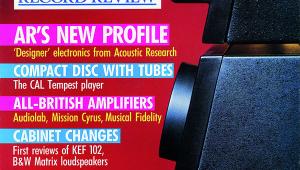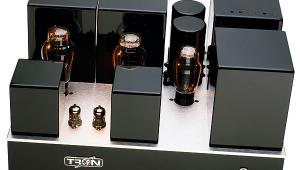Three loudspeakers: Leak, Lentek and Chartwell
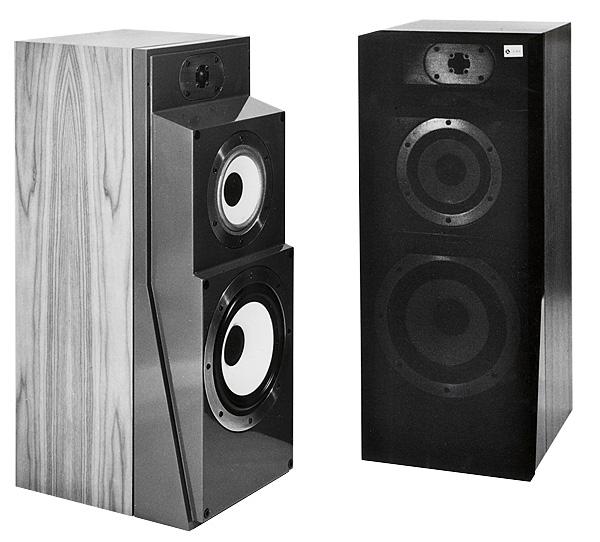
Here we audition three models ranging in price from £250-£300 and all from British manufacturers. But which will top our trio when it comes to musical performance?
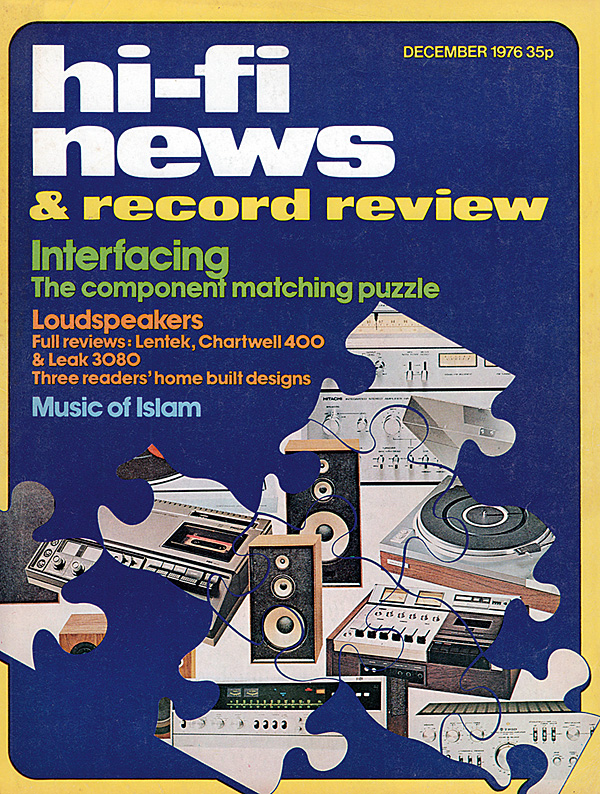
Leak 3080
The 3080 is the largest of the Leak 3000 series time-delay compensated loudspeakers. The main part of the enclosure is a rectangular box, finished in 'teak' (what else?), with a black painted back. To the front of this box is attached a grey moulding of thick plastic, having a stepped front to accommodate the three units. The first 30mm of the moulding at the top is flush with the sides of the wood part, after which it is stepped slightly in to leave a forward-facing ledge, vertical at the top and sloping outwards at the bottom. Against this ledge butts a wooden-sided frame, covered with black semi-transparent material, which completes an overall rectangular shape.
The midrange unit is the middle one, and this is enclosed internally in a cylindrical tunnel made from a thick cardboard-like substance, leaving the remainder of the space for the bass driver, with the usual sealed tweeter in the top. The front of the moulding is stepped to provide the correct phase alignment of the units, taking into account the effective source positions in each case, and also phase-shifts in the crossover network.
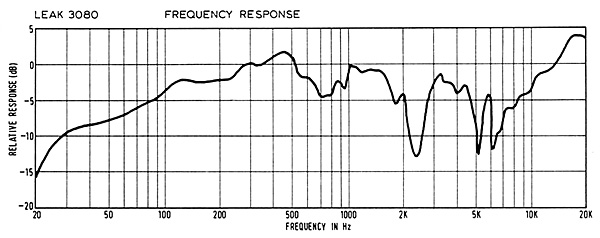
The inner sides of the wooden part are damped with felt pads, and a considerable quantity of damping material is packed into the complete enclosure. The crossover PCB is screwed to the inside of the back face, at the bottom of which is a recessed panel with a 2-pin DIN input socket and a pair of screw terminals. The three units are fixed by Allen set-screws into threaded holes in the plastic, and have wide, flat flanges without sealant. The unit connections seemed a little flimsy but the general construction was to adequate domestic standards.
The loudspeaker does not require a stand under normal conditions of use, and is extremely stable. The best position was found to be at an angle of about 45o to the wall, with the nearest corner about 20cm from the side, and 1m from the end wall.
Larger Than Life
Direct comparison with our reference Quad ESL loudspeakers showed that, while the general quality was pleasant, there were some clear differences. Orchestral sounds were somewhat harder in the treble, the upper brass being more prominent, while woodwinds seemed hollower in the lower registers. Side drums were more prominent, and the guitar a bit fatter in the bass. With harpsichords, plucking noises were more obvious, and so was tape hiss.
The general sound appeared to be more concentrated around and beyond the speakers, with less ambience in the middle, giving a cooler impression of smaller sources, such as chamber orchestras.
Putting the speakers closer did round out the image, but slightly at the expense of bass balance. With organs, 4ft principals became a trifle stringy, and sharp mixtures more edgy. The deep bass was firm, and not dissimilar to that from the Quad ESLs. Applause was more hollow, as was the lower-middle range of some sources, particularly the piano.
The stereo imaging was good, though a little more diffuse than the Quad ESLs in central positions, and held good over a sensible horizontal range. Indeed, there were no easily detectable changes in sound quality with horizontal movements, but distinct changes occurred with vertical movement.
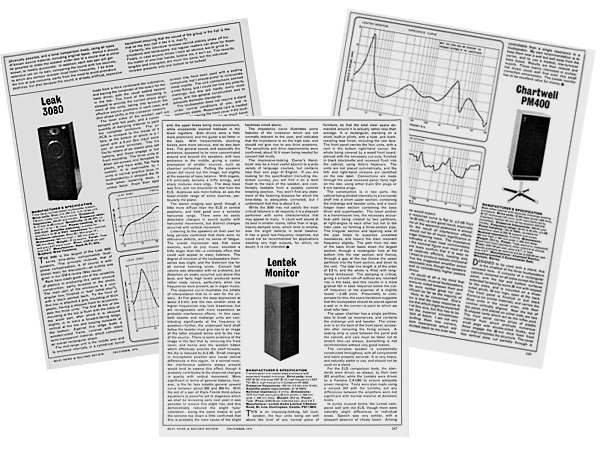
Listening to the speakers on their own for long periods confirmed that there were no obtrusive defects, and no sense of fatigue. The overall impression was that some sources, such as pop music, sounded a trifle larger than life – a contrasty effect that could well appeal to many listeners. The degree of intrusion of the loudspeakers themselves was slight, and the distortion low for all normal listening levels. Concert hall volume was attainable with no problems, but distortion on peaks occurred just above this level, and fairly high levels produced some rather nasty noises, particularly when low frequencies were present, as in organ music.
As for the response curve, the deep depression at about 2.5kHz and the two smaller ones at higher frequencies may look disastrous, but are recognisable with more experience as probable interference effects. In this case, both tweeter and midrange units are contributing significantly at the frequency in question. Further, the undamped hard shelf below the tweeter must give rise to an image of the latter situated below and to the rear of the source. There is some evidence of the image in the fact that by removing the front cover, and hence also the wooden batten which effectively extends the shelf forward, the dip is reduced by 2-3dB.
More significant is the far less notable general upward curve between about 100Hz and 800Hz. With a pair of Klark-Teknik third-octave equalisers it was possible to remove this slight rise, and this reduced the slight 'tube' coloration. Using the same means to pull the extreme top down a little confirmed this is probably the main cause of the slight hardness noted above.
While the 3080 may not satisfy the most critical listeners in all respects, it is a pleasant performer having some characteristics that may appeal to many. It could well sound at its best in smaller rooms, rather than in large, heavily-damped ones, which tend to emphasise the slight defects in tonal balance. It has a good low-frequency response, but could not be recommended for applications needing very high outputs, for which it is not intended.
Lentek Monitor
This is an imposing-looking, tall loudspeaker, the four units being set well above the level of any normal piece of furniture, so that the total clear space demanded around it is actually rather less than average. It is rectangular, standing on a short, built-in plinth, with a teak finish, including the rear face. The front panel carries the four units, with a vent in the bottom right-hand corner. The whole is covered by a wood front board, pierced with the necessary cut-outs, finished in black stockinette and recessed flush into the cabinet using Velcro fasteners. The units are not placed symmetrically, and the left- and right-hand versions are identified on the rear label. Connections are made through the usual recessed panel using either 2-pin DIN or 4mm banana plugs.
Below The Line
The construction is in two parts, the cabinet being divided internally by a horizontal shelf into a short upper section, containing the midrange and tweeter units, and a much longer lower section containing the bass driver and supertweeter. The lower portion is a transmission line, the necessary acoustical path being created by two partitions, at right-angles to each other but not to the main case, forming a three-section pipe.
The irregular section and tapering of the pipe helps to suppress unwanted resonances, and lowers the main resonant frequency slightly. The path from the rear of the bass driver leads down the largest section, through a rectangular hole at the bottom into the rear section, and then, through a gap at the top (below the upper partition) into the front section, and down to the vent. The total line length is of the order of 2.2m, and the whole is filled with lambswool.








